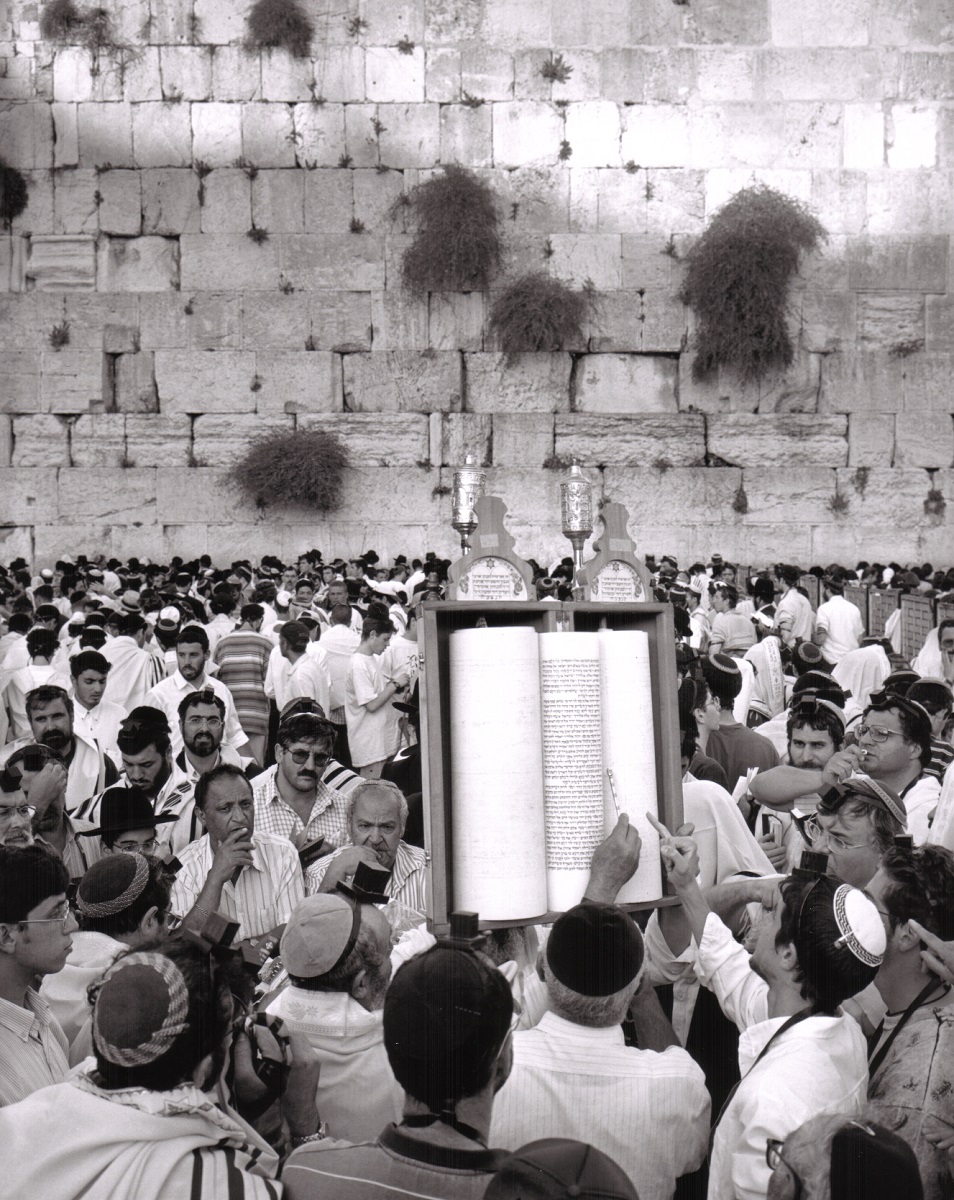Jewish Lens Mini Course - Lesson 1: Reading a Photograph
| Overview: | In this lesson, students practice their close-looking and visual literacy skills by making objective and subjective observations of a photograph and then responding to the image through creative writing. |
| Schedule: | 1-2 Class Sessions
|
| Materials: |
|
| Preparation: | Set up projector at front of classroom. If laptop and projector are not available, make one high-resolution photocopy of each photograph and send digital copies to students through email. Additionally, prepare copies of Worksheet B for the class. Inform students ahead of time that they should bring a camera, whether it be their phone or otherwise. |
| Goals: |
|
| Big Idea: | Photography is a form of communication. One can “read” and respond to a photograph in ways that are analogous to reading and responding to written texts. |
Cave, Haidan A-Sham, Yemen, 1992
Introduction (10-20 minutes):
As part of the Jewish Lens, we are going to be looking at, talking about, and taking photographs. Just as we use words to communicate, we can also communicate ideas, emotions and stories through images.
Ask the class some questions about their photo-taking habits, such as:
1. How many photographs do you take per day/ week?
2. What are these photographs of?
3. What can make a photograph memorable or impactful?
4. Of the photos you see on social media, what types tend to be the most memorable to you?
5. Where do you see Jewish photos in the media—if you do at all?
Social media is a good example of the importance of the visual language of images in our lives today. It is not only a powerful language, but a universal one as well.
Statistics to share with the class that show the large role photography plays in our society:
– 300 million photos are uploaded to Facebook each day
– 95 million photos are uploaded to Instagram each day
– On Snapchat, 9000 photos are taken every second.
*All statistics are as of 2018.
Alternative introductory activity:
Ask the students to find one image on their phone that they took in the last week and to explain to the class what the photograph says about them. This activity can be used to emphasize the photograph as personal communication/expression. Show the following Jewish Lens photos. Each of these students has created a photo inspired by the theme “my connection to the Jewish people”.
“Ahava in Hebrew means love, and symbolizes unity. Jews have special connections based on love for one another, Israel and God. Two girls display their friendship next to the student-created Ahava sculpture at the American Hebrew Academy.” Ahava – Jeanette Hamui, American Hebrew Academy, Greensboro, North Carolina, USA
Jeanette’s connection is based on the concepts of love and unity.

Students at Or Avner hold their hands and create the Star of David. Together, they portray their strong friendship and Jewish life in remote Siberia. The younger generation become active members of the Jewish people, keeping traditions alive and building a strong and vibrant community.
Robert’s connection to the Jewish people revolves around the values of friendship, community and keeping traditions alive.

“The custom of drinking mate has existed in Argentina for thousands of years. Alan documents his grandparents in this traditional ceremony, but wishes to remind us that with tradition comes a commitment to remember and a responsibility not to forget.” Mate O’Clock – Alan Katz, Instituto Yavne, Uruguay
Alan’s response to the Jewish Lens project is to consider historical memory; an aspect of Jewish identity that we all have in common, along with the responsibility that comes with it to remember.
To conclude, ask the students: What connects these images?
How might they play a role in telling the story of the Jewish people?
We see here different ways in which people feel a part of the same story – the story of the Jewish people. The participants have expressed through photographs particular elements of universal Jewish life and identity that feel personally relevant to them, for example: community, love or the Hebrew language.
Each of the photographs reveals an individual perspective but altogether we see the diversity of Jewish identity (and of how people relate to the Jewish people) as reflected in the eyes of teenagers from around the world.
What do we see? What don’t we see? (15-20 minutes)
This is an exercise in comparing objective and subjective observations to help students organize and reflect on their observations. (Note for educator: see this sample video demonstrating the exercise)
To begin, ask the students: What the difference is between an “objective fact” and a “subjective interpretation” – ask them to give examples of each.
Explain that an objective observation is something that doesn’t change from person to person, it is something that we can all agree on, such as “there are X number of people in this photo,” whereas a subjective observation is an opinion, feeling or interpretation, such as “I think they look happy/sad.”
Once the class has successfully differentiated between the two concepts, project or distribute the photograph “Cave,” as well as copies of Worksheet A.

Zion Ozeri, Cave, Haidan-A-Sham, Yemen – 1992
Working as a group, ask the students to look at the picture and say what they see. Each time a student makes an observation, ask the class to determine whether it is an objective or subjective one. Once the class is in agreement, ask them to make a note of it under the appropriate column on the worksheet (alternatively, this can be done on the board by the teacher/students).
In order to get the students to slow down and really look at the photograph, encourage them to support their subjective interpretations with objective ones, such as “What did you see in the photograph that made you say that?” or “Why do you think that?”
To wrap up, ask students what one can and cannot learn from the photograph. What questions does the image raise? Is there any additional information they would like to know about it?
Explain to the students a little about the image: the photograph was taken by an Israeli-born photographer named Zion Ozeri. Ozeri travels around the world photographing different Jewish communities.
“In this image we see boys gathered in a cave in a town called Haidan A-Sham in a rugged and mountainous part of Yemen to study the weekly Torah portion. We can see that the Jews there made use of whatever spaces were available. Since the time this photo was taken, most of the Jews have left that part of the country and moved to bigger cities or to Israel.
Jews first moved to Yemen in ancient times. They practiced their religion faithfully throughout the centuries but were generally treated as second- class citizens by the Muslim authorities. As a result of this, as well as their longing to return to the Jewish homeland, Yemenite Jews started immigrating to Israel in the late 1880s. Today only a tiny number of Jews remain in Yemen.”
If you have more time, you can show a few more of Ozeri’s photographs (Ozeri’s Portfolio).
Note: Here the photograph “Cave” has been used as the example, however, one of the following can also be used, depending on which you feel is most relevant for your students.
The Secret, Mevaseret Zion Absorption Center, Israel – 1990
“During the 1980s and 1990s, many Jews came to Israel from Ethiopia and the former Soviet Union for religious freedom and a better life. These immigrants often lived in special apartment buildings, called “absorption centers,” until they could find more permanent homes. Absorption centers provide temporary housing and an introduction to Israeli life for many new immigrants.
The photographer, Zion Ozeri, explains how important these centers are: “The first few steps of any immigrant are very difficult not knowing the language, not knowing where to buy things, where to go. The Absorption Center helps the new immigrant. It’s something I don’t know if they have anywhere else in the world. It’s a place where you can ease yourself into it. For the first few months at least, they give them some money to buy food, and there is an Ulpan (Hebrew class) for teaching the language. They kind of initiate them into new life in Israel, and how to deal with everyday things from the very, very simple things – like shopping in the supermarket – to finding a job.”
The two boys in this picture are in a kindergarten class at an absorption center near Jerusalem. One boy is from Ethiopia; the other is from the former Soviet Union.”
Tisha B’Av, Western Wall, Jerusalem, Israel – 1997
“Tisha B’Av, the ninth day of the month of Av, marks the destruction of the ancient Temple in Jerusalem. This event happened almost 2000 years ago, yet Jews around the world still mourn the loss every year on Tisha B’Av. And what better place to observe this day of mourning and fasting than at the Kotel Ha-Maaravi – the Western Wall of the Temple Mount. In this picture, people have come from all over Israel to attend services at the Wall. In the foreground, you can see men reading from a Torah scroll that’s kept in a wooden case. Sephardic Jews traditionally use this type of container to hold the Torah, rather than the cloth coverings common among Ashkenazi Jews.”
Composing a Photograph (10-25 minutes)
Composition refers to the way the contents of a photograph are arranged within the frame. There is no right or wrong way to compose an image, but by considering some of the following aspects you can more effectively communicate an idea or understand why a photo has a particular effect.
Introduce the following elements of photography by using and comparing the three Ozeri images above. (“Cave,” “The Secret,” and “Tisha B’av.”)
Start by asking the students to consider from which viewpoint or perspective we are viewing each scene.
In “Cave” we are on eye-level with the children, however in “The Secret” we view the children from slightly above. What difference do these differing perspectives make on the way we look at/interpret the scene?
In “Cave,” perhaps we feel that we are part of the group, it feels like an intimate scene, whereas in “The Secret” a distance is created – we are quite clearly not involved in the telling of the secret. We are also viewing the subjects from an adult’s perspective – this angle emphasizes the children as being smaller.
Next consider framing with the class.
Compare the photographs “Cave” and “The Secret.” What is included in the frame? What do you think the photographer might have left out of the frame?
In “The Secret,” we are zoomed in closely to the two boys, everything except the book is shut out, creating a kind of intimacy. In “Cave,” we intentionally see the environment, the surroundings in which the group find themselves.
Ask the class: Why do you think it was important for Ozeri to include this information — both the book, and the cave? How do they help us to understand more about the subjects and their situation?
The inclusion of the book tells us something about the story of these two children – they have just arrived to Israel from two different countries and speak different languages. Learning the Hebrew language will have been of great importance for their integration into the new country. It also makes us ask questions: How long have the boys been in Israel? Do they speak Hebrew fluently yet? They are clearly communicating through language, so we wonder how exactly. We can see here the inclusion of the book is a tool to make the viewer want to know more about the story of the two children, as well as to consider the difficulties faced by new immigrants.
The inclusion of the cave also adds context – it tells us something about the place this community live in and what kind of life they lead there.
What is the focal point in the photograph?
In “The Secret” it is clearly the two boys. The photographer has made sure of this by cutting any other contextual information out. In “Tisha B’Av,” the focal point is the Sefer Torah.
How has the photographer made this the focal point of the photograph?
First of all, the Torah scroll contrasts with its surroundings and therefore stands out.
Here we also have a good example of the use of foreground vs. background. Background, middle-ground, and foreground are the different planes or layers of a photo. The Torah scroll is close to the camera therefore it is in the foreground, and the Kotel is further away, therefore it is in the background. The people standing behind the Torah are in the middle-ground. They work together to create a sense of a three- dimensional space, and this depth allows the Torah scroll to stand out. In comparison, the scene in “The Cave,” is flat, probably because there was not enough space in the cave to create this effect. This confirms the impression we get of the kind of place the Cave is – small and cramped.
Photo Mission (20-30 minutes)
Distribute cameras or have students use their own.
To practice the concepts we just learned: ask students to find and photograph something round, something red and something living in the classroom/ building/right outside the building.
They should take into account all of the compositional aspects previously discussed and aim to complete all three items on the above list
The students should experiment and make lots of images, but then choose one final image (for each item on the list) to display and talk about to the class in the review.
Tell the students to experiment with:
- Shooting from different perspectives: from up high, down low. Notice how this affects the size of your subject: Does it appear bigger or smaller?
- Moving around your subject to shoot from different sides.
- Framing: getting in close and then stepping back for a wider shot. Consider what you want to include, and what is irrelevant and should be cropped out.
- Horizontal/ vertical framing.
Review the images afterwards, asking a few of the students to share their photographs. Students can email their photographs to you to be projected in the class. In order to help them reflect on their work, you can ask them:
- What did you take a photograph of and why?
- What compositional aspects did you take into account? (For example: framing or angle)
- What is the focal point of the image?
- What were you trying to communicate?
- How would you improve the image if you had the chance?
Remind the students that they can upload these images to Instagram and use the hashtag: #jewishlens.
Optional activity for extra class time or as a take home project: Ask the children to respond creatively to Ozeri’s “Cave” with one of the following ideas
Have students respond in one of the following ways to the photograph:
- Write a monologue from the point of view of one of the people in the photograph (this could also be in the form of a postcard).
- Make a photocopy of the image along with thought-bubbles above the heads of some of the figures. Have students fill in the bubbles with what they think the subjects in the photograph are thinking.
- Have students paste a photocopy of the image in the center of a piece of white paper and ask them to draw what they think is happening outside the frame of the photo.
- Have students assume the physical positions of the figures in the photograph and then ask them to act out the scene.
- Or respond to the photo creatively in their own way.
Afterwards, ask a few students to share their work with the rest of the class.
Wrap-Up (5-10 minutes)
Discuss with the students:
- What makes a photo inherently Jewish?
- How does the composition add to the meaning/impact of a photograph?
- How is reading a photograph like reading a text? How is it different?
The program you are embarking upon, known as the Jewish Lens, culminates in an International Photo competition that targets teens worldwide. The works created in your class will be displayed in a local photo exhibition, and the outstanding works will be chosen by a dedicated board of judges, directed by renowned photographer Zion Ozeri.
Optional Take-Home Project
Ask students to log on to the Jewish Lens website to view additional photographs by Ozeri and to learn more about the program.
Additionally, if they search for #jewishlens they can get a ‘behind the scenes’ look at images from other teenagers around the world also taking part in the competition.




